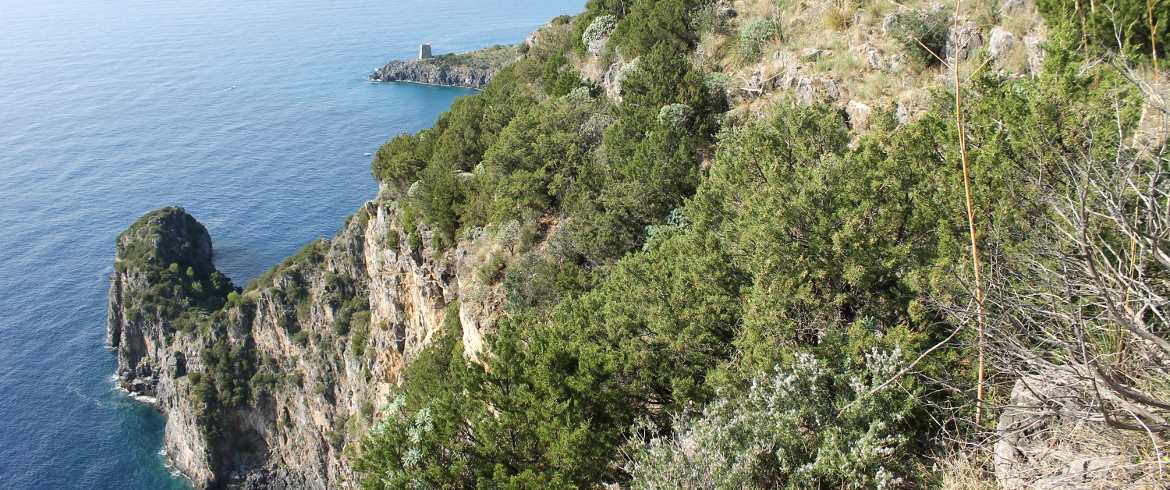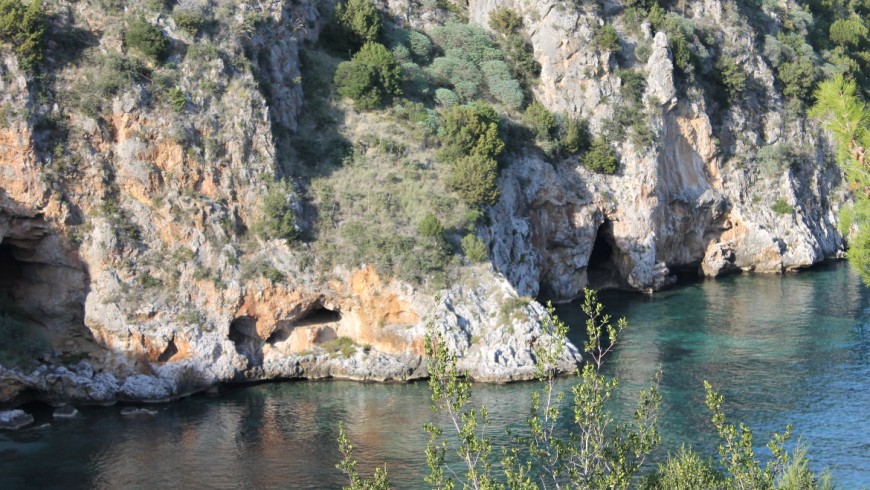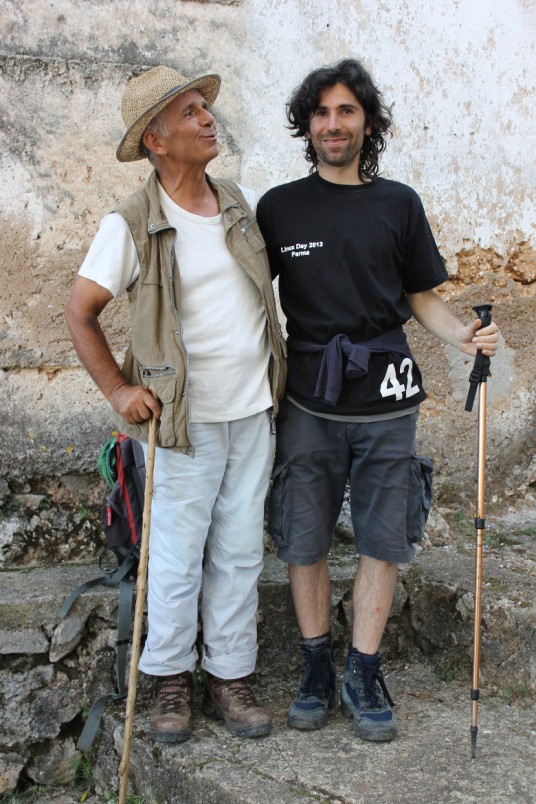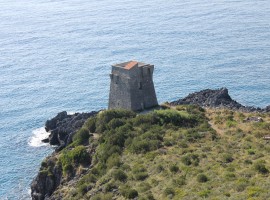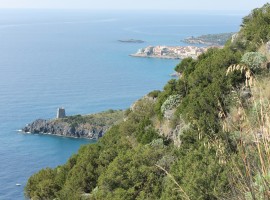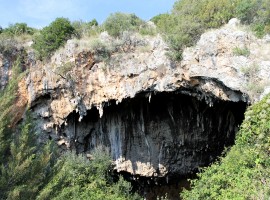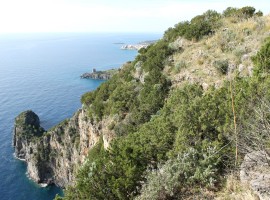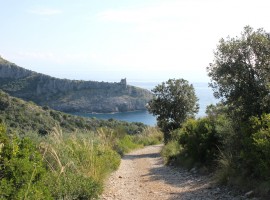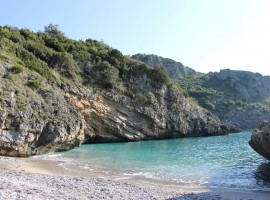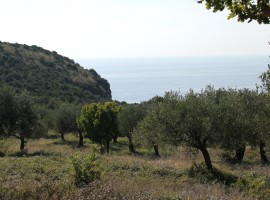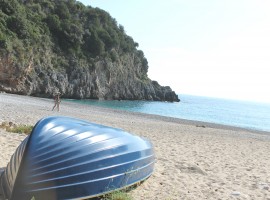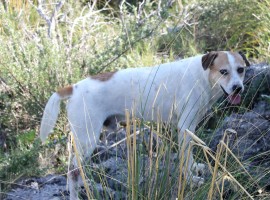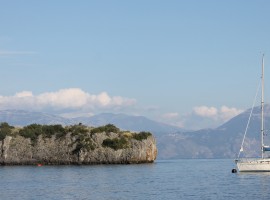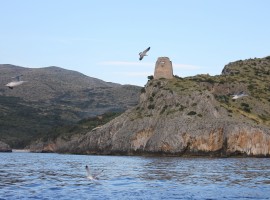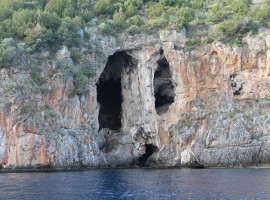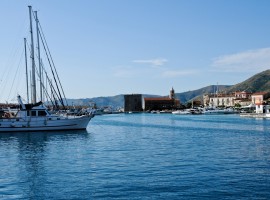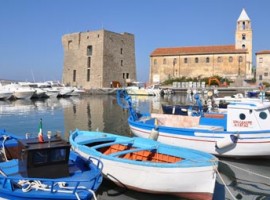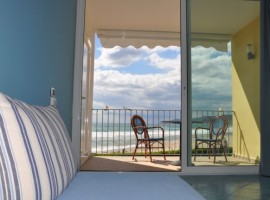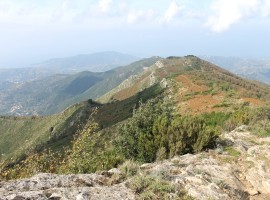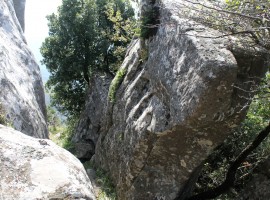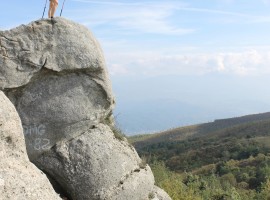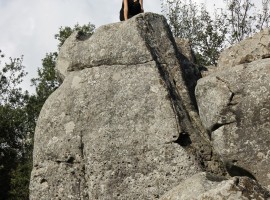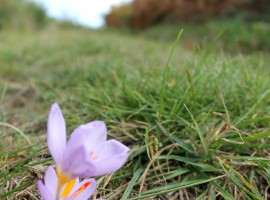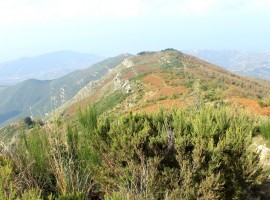A journey in the Coast of Myth, where the ancient Greece embraces a wild nature, rich in perfumes and flavours, as cradle of the Mediterranean diet. You’ll be spoilt for choice, among pure coasts – where Ulysses’s mermaids used to sing – caves to discover, scented hills of cedar and olive trees to reach on old mule tracks (either on foot or on a donkey’s back). Not to miss this territory characterized by its ancient and intense charm – its prices are still modest. We suggest you should do two striking walking tours, and stop at Acciaroli, the little village above the sea which, thanks to the stories told by its fishermen, enchanted Hemingway.
The first itinerary, on the traces of Aeneas, is one of the most wonderful paths above the sea in all of Southern Italy. Here, following an old mule track, you go through green terraces, high cliffs, rocky coasts well known by ancient Greeks due to its wuthering waters and more than white beaches. Neither in winter could you prevent from bathing in the sea!
The second one, the way of the gentle flowers, is a delicate crest track crossing arcane and mythical places, on the discovery of the “Stonehenge of Cilento”.
Among pure mountains and a crystal clear sea, those 1,800 km through the paths of the Parco Nazionale del Cilento e Vallo Diano (National Park of Cilento and Diano Valley), will tell you the thousand-year old story of a place blessed by Gods. A place which nowadays just attracts anyone who loves green tourism: in fact, such place is the first Italian geo park which, together with the sea areas of Santa Maria di Castellabate and Baia degli Infreschi, is safeguarding one of the greatest protected areas in Italy.
On the traces of Aeneas. Walking between the sky and the sea, from Marina di Camerota to Punta Infreschi
Palinuro, Aeneas’s helmsman, was the Troyan hero who survived after the destruction of Troy. Landing on the coasts of Cilento, he fell in love with a beautiful girl, named Kamàraton. Still, for he was not loved back, he tried to capture her reflected image in the sea waters, and drowned. The goddess Venus, as a punishment, transformed the girl into a rock, that is the rocky spur where nowadays is Camerota (it really derives from the ancient Greek kamaròton, meaning “curved”). The ancient buildings of the village have no foundation, as they lay directly on such rocky spur. It overlooks the valleys full of olive trees kneeling over the sea. Quite near to the historic centre of Camerota, you will find Contrada di San Vito, with its many tiny shops where an ancient knowledge was handed down over the generations, working with clay, which dates back its origins to the ancient Greece. Proceeding more below, you will find Marina di Camerota, where its luxuriant, Mediterranean greenery meets the sea.
From this little, wonderful sea village of the XIX century, you won’t miss a great walking itinerary passing through scented terraces, high hills, rocky coasts, more than white beaches and crystal clear water. Walk about 3 km (about 2.5 hours) from the little harbor of Marina di Camerota until reaching Grotta di Lentiscelle along an old mule track which suddenly presents breath-taking views over the sea. Walking along silent bays and clefts, you arrive at Punta Infreschi, one of the greatest beaches in Italy, which can only be reached on foot or boat.
Salvatore, “The man beloved by stray dogs, who would rather be loved by a woman” (as he ironically says of himself) is our exceptional tourist leader.
Provolone and Aeneas, the two stray dogs “adopted” by the community, accompany us throughout the 7 km walking tour from Lentiscelle (Marina di Camerota) to Cala Bianca, then to Punta Infreschi.
Thousands years ago, this section of land used to be sea. Here, the marks on the rocks tell us about a time when, during the warmest periods in history, the water was able to reach 12 m of height above the current sea level. It’s hard to imagine how, quite different animals lived in that section of coast, long ago: in fact, they were the same animals which can now be found in Africa, as well as the flora in the Red Sea. Can you believe it? In the cave of Poggio, home to Neanderthal groups in pre-historical times, the bones of African animals were found. And yet, there are even traces of the coldest periods in time, which came after the ice ages. According to this, we find out that dears lived on the highest mountain in the park, the massif of Cervati, until 1800. Therefore, the landscape still shows the traces of alternating both warm and cold periods in the millennia, and this fact had an impact on its greenery and fauna.
You walk along a sandy bay which is a perennial garden, surrounded by yellow flowers, sea salads and agrocasto plants: its bromide based flowers were used in the monasteries to reduce the monks’ sexual appetite, acting as a contrary viagra! Salvatore reminds us that we are in the Oriental monkism area. In the 7th century a.C., Saint Basilius, founding father of monkism, landed right here. He then went up, discovering the peninsula, bringing also some plants with him, from Aleppo pine, which now covers the Palinuro pine forest, to the arbutus (“hairy rowanberry” in local dialect), for it is the symbolic plant of Salerno. Even the coat of arms of the municipality of Camerota shows a house placed on wheels, among silver fish which leap onto the blue waves, as to remember the long journey made on the Greek monks’ ships, moving together with the Byzantine generals’ fleet until landing at these coasts. Here and there along the bay, we may find some pieces of pumice stone, as trace of Greek passage, who landed on the continent from Aeolian islands through this coast, stopping for a while at Punta Infreschi (the arrival destination of our itinerary) in order to collect sweet water running down from the mountain.
Who else more than Salvatore – a farmer “lended to the school” (he worked as a teacher for years), then “lended to politics” (he was assessor in the municipality of Camerota and succeeded in interrupting a land speculation over the coast, a horrific project of 6,000 apartments facing the sea, which would have destroyed part of such wonderful, wild landscape which we have just walked through), and last but not least, “lended to culture” – could tell of this wild coastal area rich in history, less renowned than the neighboring Amalfi Coast, still not less gorgeous?
Surrounded by an intense green which completely attracts your sight, you walk through a scented, colorful nature. A breath-taking view opens up, all of a sudden: only blue, crystal clear sea everywhere. From here, to reach the bay of Cala Fortuna, old naval base of Greeks and Etruscans (then destroyed in 1400 and never recovered afterwards) you walk down gently accompanied by scented olive and cedar trees.
Beyond the bay, a path covered with wild, saffron flowers will bring you to another great panoramic view over the sea, near an old optical telegraph. Here, you will be able to admire the whole coast of Basilicata and Calabria regions. Then, you walk through a rich, luxuriant greenery: fennel plants, the wood of which has always been used to manufacture stools and light chairs; briar-root, to produce pipes, and carobs, the fruit of which is rich in proteins and was used to feed human beings as well as animals.
Along the way, you can visit one of the oldest, inhabited caves in Europe. By entering there, you can easily feel protected by the mountain and experience a farmer’s daily routine: from the water collection through amphoras in the great tank, to the bread cooking which left some black, soot marks on the huge walls of the cave.
Walking down along a rocky path – characterized by clear, rounded stones – although red and sandy at times, you get to the white and wild beach of Punta Infreschi. Protected marine riserve and natural heritage of rare beauty, is named after the springs of cold, sweet water running out of the sea bottom – where you can also enjoy a dive!
From here, we suggest you go back to Marina di Camerota by the sea, accompanied by a local fisherman, and you will admire all of the coast, while you are followed by some flock of seagulls in search of food. The hills and high, rocky coasts dominating the sea will get your attention due to their particular shapes: a skull, and then a huge moon.. The hill of Moon’s mouth is so called not only for its shape, but also because the moon in the village of Camerota rises right behind this high rock.
Along this rocky coast, accompanied by Ulysses’s mermaids, in Summer nights you can take part in a night fishing called “Lamp”. A big lamp set on a small wooden boat enlightens the waves, attracting the fish, which is then collected by fishermen as they jump directly onto the boats, as if it was a dance in the moonlight… after that, fish is fried and eaten together, in a small bay.
Useful information: Walking itinerary: Lentiscelle (Marina di Camerota) – Cala Bianca – Punta Infreschi. Walking time: 2.30 hours, 100 m.a.s.l. altitude gap. Tourist Leader in the Park: Associazione Posidonia, info@posidonia-cilento.it, Salvatore Calicchio, mobile +39 333 5953513.
- On the traces of Aeneas, ph. by E. Benigni
Acciaroli, where Hemingway’s sea meets the Park of Cilento
Little harbors, wooden boats here and there may remind you of “The old man and the sea” by Ernest Hemingway. It’s not a case, then, that the American writer was believed to pass whole days at the little Harbor in Acciaroli, observing the life of the village and listening to the stories told by its fishermen, while keeping in hand his precious notebook and a glass of Amarone, his favorite wine. Plus, if you read through the pages of such masterpiece, you will find the stories of the fishermen in Acciaroli: the one with the old man fishing alone on a sailing boat, or the other one about the capture of a swordfish weighing more than 100kg… just to mention a few.
Nowadays, the sea in Acciaroli has become “Hemingway’s sea”, and the elderly people in the village still talk about that. Ancient and modern myths link together in this track of coast. In spite of the tourism, the coast is still pure and, besides being awarded as the cleanest sea in Campania, it was included in the Unesco World Network of Biosphere Reserves. Ever since the beaches in Acciaroli were awarded the Blue Flag and 5 sails by Legambiente, this old village of fishermen has become a symbol of sustainable tourism.
So, how could you discover each and every secret cave, enjoy each and every hidden bay with its pure waters, the surfers’ paradise? We suggest you stay some more in the pearl of Cilento, hosted at an eco-sustainable resort such as “Ancora” Residence , ideal destination for nature lovers and those people travelling with children. Here, among the green areas of the National Park of Cilento and the blue sea, within walking distance from the clear beach, Hemingway’s little harbor and the historical centre of Acciaroli, you will discover the old and intense chant of Cilento, and you will come back to the origins.
- Acciaroli, ph. by Alessandrathestrange, via flickr
- Acciaroli, Salerno, Italy
- “Ancora” Residence in Acciaroli
Walking up to high altitude, to discover the obscure powers of the “Stonehenge of Cilento”
From deep sea, up to high altitude. You’ll soon be surprised when, after a few hours’ walking, you will find yourself on the crest of one of the highest mountains in the park, in the green heart of Cilento. You will be able to have a bird-view over forests, rocky coasts and the medieval villages of Trentinara, Soprano, Sottano, and Capaccio, where the Black Madonna is the symbol of land and fertility.
Starting from Perdifumo (thirty minutes North from Acciaroli, and ten minutes from Castellabate towards the mountain), 20 minutes’ walking will be enough to immerse into a mountain landscape. A sweet, green path covered with wild flowers and colorful crocus, from which you get saffron, accompanies tourists to Sella di Corbara (700 m.a.s.l.), then to Mount Sella (1130 m.a.s.l.). Out of the blue, Mount Gerbison appears: “sacred mountain”, which you can admire in all of its greatness. It is one of the seven sacred mountains, each one protected by a Madonna, to be found between Basilicata and Campania regions.
Walking along the crest, surrounded by an impressing landscape, you get to Pietra di Mulaccio, where great rocky monoliths are set in the middle of a green valley. Stones have always fascinated the mankind, who has attributed some meanings, virtues and magic powers to them. Even these huge rocks, which you can climb with a light, wooden ladder, are commonly believed to own an “obscure” power. As proof of that, the sunrays on the day of the Winter solstice pass right through the empty space between the rocks. Therefore, you shouldn’t be surprised by the sense of respect and mystery which these place still arises in whoever is walking past them.
From Mount Stella (unfortunately, it suffered the uncontrolled, human invasion of radio and tv antennas), to San Mauro Cilento there is a long, slow descent. You can benefit from it, by picking up mushrooms and chestnuts, which together with white figs and olive oil have always been at the basis of local food habits. The mix of colors, perfumes and landscapes will help you come back to the origins, thus recovering an ancient, deep relationship with Nature, land and food.
Useful Information: The way of gentle flowers. Perdifumo – Mount Stella (1130 m.a.s.l.) – San Sebastiano – San Mauro Cilento (650 m.a.s.l.), 600 m.a.s.l. altitude gap, 4 hours, 8 km.
- Way of the gentle flowers, ph. by E. Benigni
No matter your itinerary, you will surely dive into a pure nature and its thousand-year old stories, full of myths, legends, and traditions to discover. No matter your walking tour, a dive into the sea is a must-do!
Useful information for your staying in Cilento:
How to get there: By train, you arrive in Salerno (about 2 hours from Rome and 5 hours from Milan with high-speed trains). Another hour by train and you get at Pisciotta Palinuro station, passing through a nice track winding through lands, olive trees, and breath-taking views over the coast.
When to travel: Spring and Autumn are the best seasons to walk and indulge yourself with some sea-bathing. Anyway, you could even find a warmer Autumn and enjoy an extraordinary, December sea-bathing!
